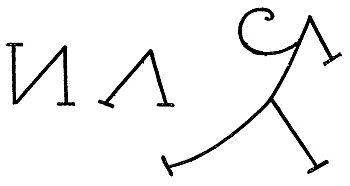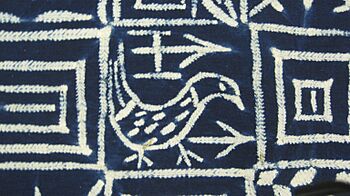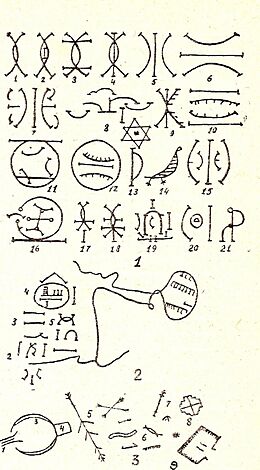Nsibidi facts for kids
Quick facts for kids Nsibidi |
|
|---|---|

A symbol simply described as "Nsibidi name written" by Elphinstone Dayrell in 1911.
|
|
| Type | Ideographic |
| Spoken languages | Ekoid, Efik, Ibibio, Igbo |
| Time period | circa 400 AD – present |
| Child systems | anaforuana (Cuba), veve (Haiti), “Neo-Nsibidi” (Nigeria), “Akagu” (Nigeria) |
| Note: This page may contain IPA phonetic symbols in Unicode. | |
Nsibidi (also called Nsibiri, Nchibiddi, or Nchibiddy) is a special system of symbols. It was created by the Ekpe secret society in southeastern Nigeria. Think of it like an early form of writing, using pictures and signs.
These symbols are mostly pictograms, meaning they are pictures that represent words or ideas. Some people also think some Nsibidi symbols might be logograms (symbols for whole words) or syllabograms (symbols for sounds).
People first learned about Nsibidi symbols in 1904. Scientists found old clay pots, headrests, and figures from the Calabar area of Nigeria. These items were from about 400 AD to 1400 AD. They had symbols that looked a lot like Nsibidi.
There are hundreds of Nsibidi symbols. In the past, children were taught some of these signs in schools. Many symbols are about everyday life, like love. But symbols about war or sacred things were kept secret.
Nsibidi can be found on many things. These include wall designs, calabashes (dried gourds), metal objects like bronze, leaves, swords, and even tattoos. The symbols are mainly used by the Ekpe leopard society. This is a secret society found among the Igbo, Ekoi, Efik, Bahumono, and other groups in the old Cross River region.
Before the colonial era (when Nigeria was ruled by other countries), Nsibidi had two main types. One was sacred and secret. The other was more public and decorative, and even women could use it. Nsibidi was, and still is, a way to share the meanings of the Ekpe society. Some Nsibidi symbols even traveled to Cuba and Haiti during the Atlantic slave trade. There, they changed into new symbols called anaforuana and veve.
Contents
Understanding Nsibidi Symbols
The word Nsibidi comes from the Ekoid language. One expert, Robert Farris Thompson, said it means "strong letters." This comes from the word sibi, which means "strong" or "powerful."
In the old Cross River region, Nsibidi is mostly linked to the Ekpe society for men. Before colonial times, the Ekpe societies were very powerful. They made laws, settled disagreements, and led people in parts of the Aro Confederacy. This included the Igbo, Efik, and Ibibio people. They had a lot of power in the old Cross River area, which is now in Nigeria.
Where Did Nsibidi Come From?
Most people today believe Nsibidi started with the Ekoi or Ejagham people. They live in the Northern Cross River area. However, in the early 1900s, J. K. Macgregor wrote that some local people said it came from the Uguakima or Uyanga section of the Igbo people.
But the Ejagham people had Nsibidi long before Macgregor was there. He might have been given wrong information. A few years later, another expert, Percy Amaury Talbot, couldn't find proof for Macgregor's story. He thought it was more likely that the Ekoi people created the system.
How Nsibidi Was Used
Nsibidi has many different signs. These signs are often put on calabashes, brass items, fabrics, wooden sculptures, costumes for special dances, buildings, and even on people's skin. Nsibidi is described as a "flexible system" of communication. It has hundreds of signs, both abstract (shapes) and pictographic (pictures).
During the colonial period, Talbot called Nsibidi a "secret writing system." He said it was used for messages "cut or painted on split palm stems." Macgregor believed Nsibidi was used like regular writing. He even had a copy of a court case record from a town called Enion. He said every detail was "most clearly described" using Nsibidi. Nsibidi was important because it connected different groups of people in the Cross River region.
Nsibidi in Court Cases
Nsibidi was used in court cases, which were called 'Ikpe' in Enion. This was an Igbo subgroup. Macgregor found and translated an Nsibidi record of an 'Ikpe' judgment. This shows how detailed and important the symbols were.
Ukara Ekpe Cloth
Nsibidi symbols are used to decorate a special woven fabric called 'ukara ekpe'. This cloth is usually dyed blue, but sometimes green and red. It is covered with Nsibidi symbols and designs.
Ukara ekpe cloths are woven in Abakaliki. Then, male Nsibidi artists in Igbo towns like Abiriba, Arochukwu, and Ohafia add the designs. Members of the Ekpe society wear these cloths. The symbols on ukara cloths include lovers, metal rods, trees, feathers, hands (showing friendship, war, or work), masks, moons, and stars.
The cloth is dyed by older women in secret. Younger males do some dyeing in public. Ukara was a sign of wealth and power. Only important men and older women could handle it.
Ukara can be worn as a wrapper (a type of clothing) for special events. Larger versions are hung in Ekpe society meeting houses. The designs on Ukara are usually white on a dark blue background. Some designs are abstract shapes that represent the Ekpe society. For example, repeating triangles show a leopard's claws, which means Ekpe's power.
Ukara also has realistic designs of objects like gongs, feathers, and manilla currency (an old form of money). These show wealth. Powerful animals like the leopard and crocodile are also included.
Examples of Nsibidi Symbols
Here are some examples of Nsibidi symbols. They were recorded by J. K. Macgregor (1909) and Elphinstone Dayrell (1910 and 1911). They published these in important journals. Both of them collected symbols from different places around the Cross River. They especially focused on the Ikom district in what is now Cross River State. Both researchers worked with local people to find secret Nsibidi symbols. They visited many communities in the Cross River area.
See also
- Writing systems of Africa
- Africa Alphabet
- African reference alphabet





